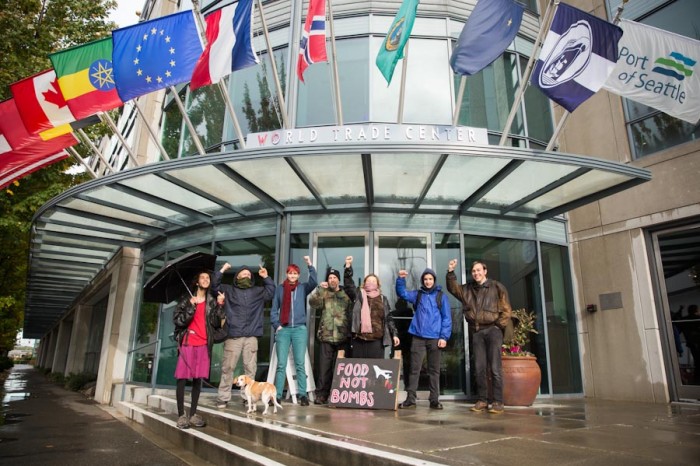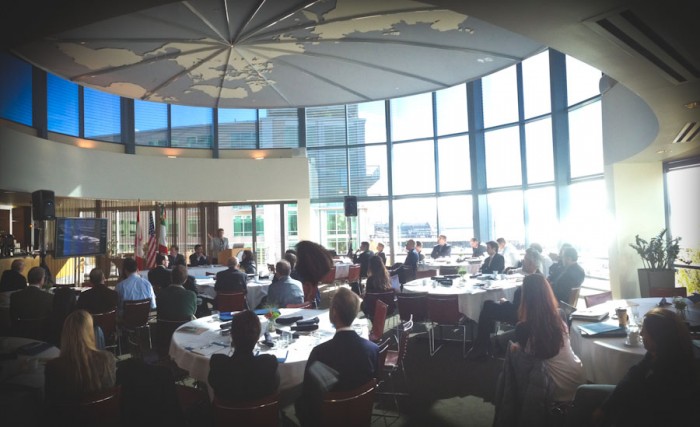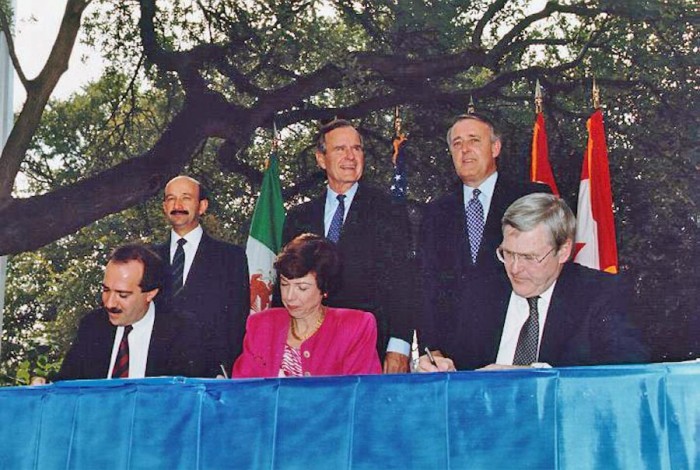
On a very rainy Seattle morning last week, a small group of people met on the top floor of Seattle’s World Trade Center, overlooking the clouded waterfront.
Edith St-Hilaire, Canada’s Consul General in Seattle, thanked us for “braving the storm” to get inside. Outside, a small but determined band of protesters was still doing just that.
We were there for a birthday party of sorts — NAFTA (the North American Free Trade Agreement) is 20 years old this year.
The first in a series of big free trade agreements, this one uniting the US, Canada and Mexico, NAFTA has certainly had it’s share of critics. But these days “free trade” is pretty much a fact of life, and NAFTA isn’t the household word it was back in the mid-nineties when presidents from both parties helped push it through.
I’d told a few people I was attending the NAFTA event, only to find that many didn’t know what it is.
“I currently don’t know if NAFTA is still in effect. Is it?” asks Rafael Flores, a bi-racial Canadian/Mexican tri-citizen, born in Seattle, who jokes that he’s been called a “NAFTA baby.”
At the meeting, which was opened up to 30 members of the public, I encountered an unlikely mix of consular officials, industry and trade experts, and protesters. The official guests were well-dressed with fancy pens and lapel pins with flags of Canada, Mexico and the United States.
Coming through the doors, guests were presented with glossy materials containing a dizzying array of numbers and graphs. I found out that North America is a trillion dollar market. The U.S., Canada and Mexico trade more with each other than with all other countries overseas.
The half-day program was consistently disrupted by protesters, hissing and expressing dissent — but overall there just weren’t that many people there. A contingent from the Canadian and Mexican Consulates in Seattle made up many of the attendees (the Canadian Consulate sponsored the event). If you don’t count staff, security, or those present because of their great misgivings for NAFTA, the number of people attending were barely more than the number who were speaking.
Christopher Sands of Western Washington University’s Border Policy Research Institute opened things up by briefly thanking economist Sidney Weintraub, known as the “Father of NAFTA” who passed away this year.
Sands noted that NAFTA has had it’s challenges, “whether it’s tainted tomatoes or cars.”

He wasn’t the only of the official speakers at the conference to paint a less-than-rosy picture of NAFTA’s legacy.
“I don’t know if the organizers knew my background when they invited me,” says Steve Gerritson, of the Washington CleanTech Alliance. “I bring a very different perspective, as Chairman of the Sierra Club at the time of the WTO (World Trade Organization) Protest.”
He states that in his view, NAFTA-type agreements should, “improve economic well-being, protect the rights of citizens, and should not deteriorate quality of life.”
His view that aspects of NAFTA have had “to put it politely: mixed results,” brings a smattering of applause and agreement from protesters in the room.
But if protesters were hoping this was a sympathetic opening, Gerritson’s brusque “please don’t interrupt the speakers” made it clear that he has the floor. Being finally given a seat at the table, he’s going to play by the rules, and say what he wants to say.
University of Washington President Michael K. Young, the keynote speaker, wasn’t giving NAFTA a free pass either.
“It’s hard to say how much can be attributed [to NAFTA],” he says. “How much is trade, how much is good economic policies, is hard to say”.
Young talks a lot about producing skilled graduates, and the rising demand for Science Technology Engineering and Mathematics skills (STEM). There is also a push for opening up work visas, as there is a real shortage of workers in those fields.
“The global shortage of STEM talent is staggering.” says Patti Brooke of the Washington Technology Industry Association. “The complete decimation of the higher ed funds by the state has led to this situation.”
Businesses wants more qualified workers, but we aren’t supporting the necessary learning to produce those workers, so there’s a desire to let foreign workers in.
This may be top priority for those gathered here today. But it doesn’t have a hell of a lot to do with free trade agreements as we know them. NAFTA’s 20 year impacts have mostly been about not letting workers cross borders. When the agreement went into effect 20 years ago, American and Canadian manufacturing moved to northern Mexico where labor was cheap and environmental regulations were lax. But of course workers weren’t granted the same free pass across North American borders.
Letting labor move freely to where the jobs are would be a sea change in how North American trade functions — but the talk at the forum was really about skilled, white collar workers, not about letting low-skilled workers come up from Mexico to the U.S and Canada.

At moments, it did seem as if this conference really was about finding new ways to approach free trade agreements.
“If you have 10 people sitting around a table, and they all have the same background, they’ll come up with the same solutions,” Young said.
Letting the members of the general public like me in was a small step in that direction. These are usually closed-door meetings.
In the Q&A after Young’s talk, we got a clue as to why.
“You mentioned that a group of 10 have a difficult time coming up with novel solutions, I think what we have here is a massive case of group-think,” says a middle-aged man in a dark coat. “All of you have an investment in wanting to believe that NAFTA has been successful. My question for you is how the fuck do you sleep at night?”
This gets applause and a big cheer, bringing the Q&A to an abrupt close.
But really, why the protester beef with free trade?
One of the complications of trade without tariffs (fees that are used to protect domestic producers from cheaper foreign goods), is that Canada, the U.S. and Mexico have wildly varying labor practices.
“In an ideal world, NAFTA would be great” says Rafael Flores, “but how will we make sure the pie is split evenly? I think that Mexico has gotten a raw deal.”
Removing those barriers has has all sorts of adverse effects, depending on who you ask: decimating American and Canadian manufacturing sectors, eroding union power, bankrupting small Mexican farmers, encouraging illegal immigration.
Canadian companies have even been subject to hostile foreign takeovers in order to take advantage of their “free trade” status.
Despite the occasional outburst at the forum, there was a generally subdued tone, both inside and amongst the smattering of protesters outside. That might indicate that NAFTA is not such a hot topic as it was 20 years ago.
But the march toward greater liberalization of trade, for better or worse, is far from over.
Negotiations are ongoing for the Trans Pacific Partnership (TPP) which would unite the NAFTA countries with a host of other Pacific Rim economies including Japan, Australia, Chile, Malaysia and Vietnam
“TPP will in many ways be the second phase of NAFTA” according to Marco Manrique of the Mexican Economy Ministry.
So far, TPP negotiations have happened behind closed doors, with the only public access to draft chapters of the agreement coming via Wikileaks.
Colin Robertson, a former diplomat who was one of the original architects of NAFTA and the WTO, seemed to have a different take on the trends in public participation with free trade agreements.
“When we did NAFTA we weren’t communicating, the way we are now.” Robertson said. He’s talking about modern social media, and has some unique ideas to jump-start cross-border sharing. For the next generation, he thinks “we need to get ‘em partying together, drinking together” for cultural exchange.
“Twenty years from now, we’ll say, hopefully, ‘North America’s better.’”

